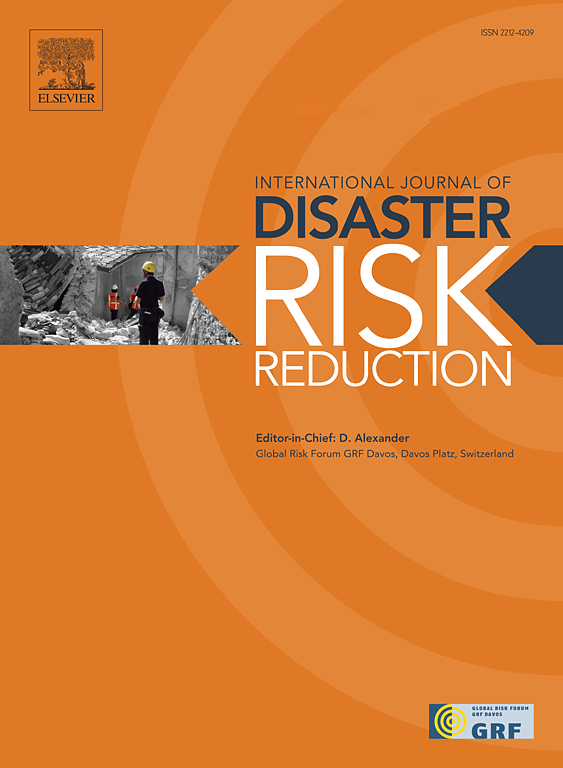重新思考气候变化中的移民:孟加拉国多方面和相互关联的驱动因素和适应性战略
IF 4.2
1区 地球科学
Q1 GEOSCIENCES, MULTIDISCIPLINARY
International journal of disaster risk reduction
Pub Date : 2025-06-12
DOI:10.1016/j.ijdrr.2025.105646
引用次数: 0
摘要
气候灾害可能影响孟加拉国西南海岸等易受气候变化影响地区的移民。虽然环境变化和人类流动之间的关系已经得到了研究,但环境如何影响移民驱动因素和模式仍不清楚。本文通过考察库尔纳城市公司和Koyra Upazila的移民动态来解决这一差距,以辨别城市和农村脆弱性的影响。我们调查了300个家庭,进行了四次焦点小组讨论和六次关键信息访谈,以揭示移民的环境、经济和社会驱动因素的相互作用。研究结果表明,在Koyra,移民主要是由飓风和盐碱化入侵等灾害驱动的,这些灾害严重破坏了农村生计。在库尔纳,经济机会和更好的生活条件反过来又影响着移民。在这两个地区,经济脆弱性放大了气候灾害的影响,尤其是对低收入群体的影响。在科伊拉,生存驱动的移民仍然存在,而库尔纳的移民越来越多地是战略决策和计划适应的结果,旨在实现长期的社会经济复原力,例如通过投资于技能发展。研究结果表明,迫在眉睫的环境压力与对经济稳定的渴望交织在一起,使移民成为一种复杂的现象。这些见解可以指导政策措施,以增强社区抵御能力,减少脆弱性,并应对不同环境下的多维移民挑战。本文章由计算机程序翻译,如有差异,请以英文原文为准。
Rethinking migration in a changing climate: Multifaceted and interconnected drivers and adaptive strategies in Bangladesh
Climatic hazards could shape migration in regions vulnerable to climate change such as the Southwestern coast of Bangladesh. While the nexus of environmental change and human mobility has been researched, how contexts shape migration drivers and patterns remain unclear. This article addresses this gap by examining migration dynamics in the Khulna City Corporation and Koyra Upazila, to discern the influence of urban and rural vulnerabilities. We surveyed 300 households and conducted four focus group discussions and six key informant interviews to unpack the interplay of environmental, economic, and social drivers of migration. The findings indicate that in Koyra migration is predominantly driven by hazards such as cyclones and salinity intrusion, which severely disrupt rural livelihoods. In Khulna, migration is in turn shaped by economic opportunities and better living conditions. In both locations, economic vulnerability amplifies the impact of climatic hazards particularly among low-income groups. While survival-driven migration persists in Koyra, migration in Khulna is increasingly a result of strategic decisions and planned adaptation aimed at long term socio-economic resilience, for example by investing in skills development. The results highlight how immediate environmental pressures intersect with aspirations for economic stability and make migration a complex phenomenon. These insights can guide policy measures to enhance community resilience, reduce vulnerabilities, and address the multidimensional migration challenges across diverse settings.
求助全文
通过发布文献求助,成功后即可免费获取论文全文。
去求助
来源期刊

International journal of disaster risk reduction
GEOSCIENCES, MULTIDISCIPLINARYMETEOROLOGY-METEOROLOGY & ATMOSPHERIC SCIENCES
CiteScore
8.70
自引率
18.00%
发文量
688
审稿时长
79 days
期刊介绍:
The International Journal of Disaster Risk Reduction (IJDRR) is the journal for researchers, policymakers and practitioners across diverse disciplines: earth sciences and their implications; environmental sciences; engineering; urban studies; geography; and the social sciences. IJDRR publishes fundamental and applied research, critical reviews, policy papers and case studies with a particular focus on multi-disciplinary research that aims to reduce the impact of natural, technological, social and intentional disasters. IJDRR stimulates exchange of ideas and knowledge transfer on disaster research, mitigation, adaptation, prevention and risk reduction at all geographical scales: local, national and international.
Key topics:-
-multifaceted disaster and cascading disasters
-the development of disaster risk reduction strategies and techniques
-discussion and development of effective warning and educational systems for risk management at all levels
-disasters associated with climate change
-vulnerability analysis and vulnerability trends
-emerging risks
-resilience against disasters.
The journal particularly encourages papers that approach risk from a multi-disciplinary perspective.
 求助内容:
求助内容: 应助结果提醒方式:
应助结果提醒方式:


